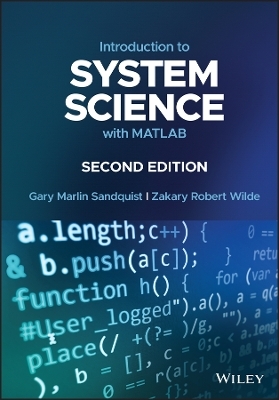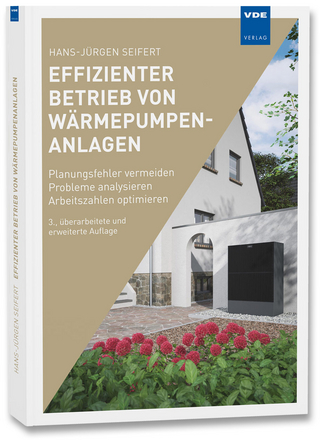
Introduction to System Science with MATLAB
John Wiley & Sons Inc (Verlag)
978-1-119-21396-3 (ISBN)
In this revised Second Edition of Introduction to System Science with MATLAB®, the authors Gary Sandquist and Zakary Wilde provide a comprehensive exploration of essential concepts, mathematical framework, analytical resources, and productive skills required to address any rational system confidently and adequately for quantitative evaluation.
This Second Edition is supplemented with new updates to the mathematical and technical materials from the first edition. A new chapter to assist readers to generalize and execute algorithms for systems development and analysis, as well as an expansion of the chapter covering specific system science applications, is included.
The book provides the mathematical basis for developing and evaluating single and multiple input/output systems that are continuous or discrete. It offers the mathematical basis for the recognition, definition, quantitative modeling, analysis, and evaluation in system science.
The book also provides:
A comprehensive introduction to system science and the principles of causality and cause and effect operations, including their historical and scientific background
A complete exploration of fundamental systems concepts and basic system equations, including definitions and classifications
Practical applications and discussions of single-input systems, multiple-input systems, and system modeling and evaluation
An in-depth examination of generalized system analysis methods and specific system science applications
Perfect for upper-level undergraduate and graduate students in engineering, mathematics, and physical sciences, Introduction to System Science with MATLAB® will also earn a prominent place in libraries of researchers in the life and social sciences.
Gary Marlin Sandquist is Professor Emeritus in Mechanical Engineering at the University of Utah. He owns and operates Applied Science Professionals, LLC, and is a Fellow of the American Society of Mechanical Engineering and the American Nuclear Society. His research focuses on nuclear science and engineering, risk assessment, nuclear and reactor physics, health physics, and more. Zakary Robert Wilde is a doctoral candidate in the Mechanical Engineering Department at Arizona State University and an engineer at Los Alamos National Laboratory. His researches focus on testing, simulation, and visualization of high-speed dynamic events as well as developing simplified models for complex physical and engineering systems.
Preface xi
1 Introduction 1
1.1 System Science 1
1.1.1 Definition of System Science 2
1.2 Principle of Causality 3
1.2.1 Definition 3
1.2.2 Common Examples 4
1.2.3 Relationship to System Science 6
1.3 Overview of System Science 7
1.3.1 Historical Background 7
1.3.2 Major System Science Achievements in the Twentieth Century 9
1.3.3 Measurable Systems and Quantitative Modeling 9
1.3.4 Application of Computers to System Science 13
1.3.5 Utilization of Computer Software in System Science 14
1.3.6 General Applications of System Science 16
1.4 Outline and Utilization of Text 17
1.4.1 Outline of Text 17
1.4.2 Study Schedules by Discipline for this Text 18
1.5 Summary 18
Bibliography 20
Problems 21
2 Fundamental System Concepts 25
2.1 Definitions of System Concepts and Terms 25
2.1.1 Concept and Definition of a System 25
2.1.2 System Causes 26
2.1.3 System Effects 26
2.1.4 Measurability of System Causes and Effects 26
2.1.5 Isolation of a System from Its External Environment 27
2.1.6 Intrinsic and Extrinsic System Feedback 28
2.2 Discussion of System Concepts 28
2.2.1 Concept of a System 28
2.2.2 Isolation of a System from the Environment 29
2.2.3 Identifying and Distinguishing Between Causes and Effects 31
2.3 Classification of Systems by Type 32
2.3.1 Irrational and Immeasurable Systems 33
2.3.2 Continuous and Discrete Systems 35
2.3.3 Deterministic and Stochastic Systems 36
2.3.4 Feedback Systems 37
2.3.5 Controllable Systems 40
2.4 System Analysis and Evaluation Using a Computer 41
2.4.1 Computer Applications to System Analysis 41
2.4.2 Symbolic Computer Applications to System Analysis 41
2.5 Summary 44
Bibliography 45
Problems 46
3 Basic System Equations 49
3.1 Functional Dependence of System Causes and Effects 49
3.1.1 Proportionality Relationship Between Cause and Effect 50
3.1.2 The System Kernel 51
3.2 Classification of System Equations 54
3.2.1 Single-Input, Single-Output Systems 55
3.2.2 Single-Input, Multiple-Output Systems 57
3.2.3 Multiple-Input, Single-Output Systems 61
3.2.4 Multiple-Input, Multiple-Output Systems 63
3.3 Summary 66
Bibliography 67
Problems 67
4 Single-Input Systems 75
4.1 Definition and Significance of a Single-Input System 75
4.2 Single-Input, Single-Output Systems 76
4.2.1 Discrete Systems 77
4.2.2 Continuous Systems 79
4.2.3 Constant System Kernels 81
4.2.4 Linear System Kernels 81
4.2.5 Exact System Kernels 84
4.2.6 Separable System Kernels 87
4.2.7 Homogeneous System Kernels 88
4.2.8 Bernoulli-Type System Kernels 90
4.2.9 Ricatti-Type System Kernels 91
4.2.10 Other Special System Kernel Types 93
4.3 Single-Input, Multiple-Output Systems 97
4.3.1 Discrete System Kernels 98
4.3.2 Continuous System Kernels 100
4.3.3 Constant System Kernels 103
4.3.4 Linear System Kernels with Constant Coefficients 104
4.3.5 Linear System Kernels with Variable Coefficients 107
4.3.6 Exact System Kernels 111
4.3.7 Separable System Kernels 112
4.3.8 Homogeneous System Kernels 114
4.3.9 Autonomous System Kernels 116
4.3.10 System Kernels Associated with Classical Second-Order Ordinary Differential Equations (ODEs) 118
4.3.11 Equivalence of Single-Input System Equations with Ordinary Differential and Difference Equations of Any Order 124
4.4 Treatment of Single-Input Systems Using MATLAB Symbolic Toolbox 128
4.5 Summary 131
Bibliography 131
Problems 132
5 Multiple-Input Systems 141
5.1 Definition and Mathematical Significance 141
5.2 Multiple-Input, Single-Output Systems 142
5.2.1 Discrete Systems 143
5.2.2 Continuous Systems 146
5.2.3 Constant System Kernels 147
5.2.4 Exact System Kernels 148
5.2.5 Linear System Kernels 151
5.2.6 Separable System Kernels 153
5.2.7 Homogeneous System Kernels 154
5.2.8 Inversion of the System Kernel 155
5.2.9 Equivalence of Multiple-Input, Single-Output System Equations and First-Order Partial Differential Equations 157
5.3 Multiple-Input, Multiple-Output Systems 161
5.3.1 Discrete Systems 162
5.3.2 Continuous System Kernels 164
5.3.3 Constant System Kernels 166
5.3.4 Exact System Kernels 166
5.3.5 Linear System Kernels 167
5.3.6 Separable System Kernels 171
5.3.7 Equivalence of Multiple-Input, Multiple-Output Systems and Partial Differential Equations 172
5.3.8 Reduction of Multiple-Input, Multiple-Output Systems Equations 173
5.3.9 Integral Equation Form of the System Equation 175
5.3.10 Elimination of Individual Output Solutions to Reduce the System Equation 176
5.4 Summary 177
Bibliography 178
Problems 178
6 System Modeling 183
6.1 Graphical Representation of Systems 183
6.1.1 Block Diagramming 184
6.1.2 Signal-Flow Graphs 189
6.1.3 Organization Diagrams 194
6.2 Modeling System Inputs, Outputs, and Kernels 199
6.2.1 Single-Input, Single-Output System 204
6.2.2 Physical Systems 206
6.2.3 Nonphysical Systems 209
6.2.4 Experimental Modeling 212
6.2.5 Stochastic Modeling 223
6.2.6 Heuristic Modeling 226
6.3 Paradigm for System Modeling, Analysis, and Evaluation 228
6.4 Summary 229
Bibliography 229
Problems 230
7 Analysis Methods for Systems with Linear Kernels 245
7.1 Background and Justification 245
7.2 Linearization Methods 247
7.2.1 Taylor Series Expansion 248
7.2.2 Perturbation Methods 251
7.2.3 Variable Coefficient Elimination 252
7.3 Single-Input Linear Systems 254
7.3.1 Single-Input, Single-Output Systems 254
7.3.2 Single-Input, Multiple-Output Linear Systems 258
7.4 Multiple-Input Linear Systems 265
7.4.1 Multiple-Input, Single-Output 266
7.4.2 Multiple-Input, Multiple-Output Continuous System Equations 270
7.5 Summary 272
Bibliography 273
Problems 274
8 Generalized System Analysis Methods 279
8.1 Simplification and Reduction of System Kernels 279
8.1.1 Conversion of Variable System Kernels to Constant Kernels 280
8.1.2 Reduction of System Kernels 282
8.2 System Normalization and Parameter Reduction 288
8.2.1 System Variable Normalization 288
8.2.2 Parameter Reduction and Minimization 292
8.2.3 Sensitivity Analysis of System Parameters 297
8.3 Systems with Feedback 300
8.3.1 System Kernel Feedback Gain 301
8.3.2 Effect of Feedback on Linear Kernels 304
8.3.3 Single-Input, Single-Output Systems with Feedback 306
8.3.4 Inversion of System Kernels with Feedback 308
8.4 Computer-Aided Analysis of Systems 310
8.5 Summary 313
Bibliography 313
Problems 314
9 System Science Applications 321
9.1 Classification of System Science by Topics 321
9.2 System Science Applications to Space, Time, Matter, and Energy in Physical Science 328
9.2.1 First Law of Thermodynamics 328
9.2.2 Particle Diffusion Model 331
9.2.3 Relativistic Mechanics Model 333
9.2.4 System Problems for Matter, Energy, Space, and Time 339
9.3 Earth Science Applications of System Science 352
9.3.1 Atmospheric Model 353
9.3.2 Geothermal Model 355
9.3.3 Terrestrial Water Balance Model 357
9.3.4 Topical System Applications in the Earth Sciences 360
9.4 Life Systems Applications of System Science 366
9.4.1 Continuous and Discrete Growth Models 366
9.4.2 The Mammalian Lung Model 367
9.4.3 Topical System Problems in Life Science 369
9.5 Applications of System Science to Human Life 381
9.5.1 Hemodynamic Circulatory System 381
9.5.2 Model for Medical Diagnosis Using Radioactive Nuclides 386
9.5.3 Quantitative Model for Stress 388
9.5.4 Topical System Problems Associated with Human Life 390
9.6 Applications of System Science to Human Society 401
9.6.1 World Cultural and Economic Regions 401
9.6.2 Solow Model for Economic Growth 403
9.6.3 Model for Cost of Crime to Society 406
9.6.4 Energy Consumption and GNP 413
9.6.5 Topical System Problems in Human Society 414
9.7 Applications of System Science to the Arts 423
9.7.1 Quantitative Assessment of Language 424
9.7.2 Art Awareness Model 427
9.7.3 Topical System Problems in the Arts 427
9.8 Applications of System Science to Technology 430
9.8.1 Nuclear Reactor Stability with Xenon-135 Dependence 431
9.8.2 Fluid Flow with Friction 441
9.8.3 Models for Forecasting Electrical Power Demand 443
9.8.4 Topical System Problems in Technology 445
9.9 Applications of System Science to Religion 450
9.9.1 Quality of Life and Belief in God Model 450
9.9.2 Models for the Great Religions 455
9.9.3 Topical System Problems in Religion 456
9.10 Applications of System Science to History 462
9.10.1 Expansion Model for Aggressive Societies 462
9.10.2 Historical Growth in Weapons Trade 465
9.10.3 Additional Modeling Problems 466
General System Science Bibliography 468
10 System Modeling Paradigms 475
10.1 Background 475
10.2 Modeling Paradigm 476
10.3 Essential System Modeling Paradigm Steps 477
10.3.1 Step-1 Explore and Document 477
10.3.2 Step-2 Define and Contain 481
10.3.3 Step-3 Select and Develop 481
10.3.4 Step-4 Construct and Quantify 482
10.3.5 Step-5 Analyze and Evaluate 482
10.3.6 Step-6 Assess and Re-Evaluate 482
10.3.7 Step-7 Finalize and Confirm 483
10.3.8 Step-8 Resolve and Accept 483
10.3.9 Step-9 Publish and Disseminate 483
10.4 Example of Analysis Process after System Identification using MATLAB 483
10.5 Final Words 486
Index 489
| Erscheinungsdatum | 13.08.2019 |
|---|---|
| Verlagsort | New York |
| Sprache | englisch |
| Maße | 170 x 244 mm |
| Gewicht | 1049 g |
| Themenwelt | Technik ► Elektrotechnik / Energietechnik |
| Technik ► Maschinenbau | |
| ISBN-10 | 1-119-21396-7 / 1119213967 |
| ISBN-13 | 978-1-119-21396-3 / 9781119213963 |
| Zustand | Neuware |
| Informationen gemäß Produktsicherheitsverordnung (GPSR) | |
| Haben Sie eine Frage zum Produkt? |
aus dem Bereich


